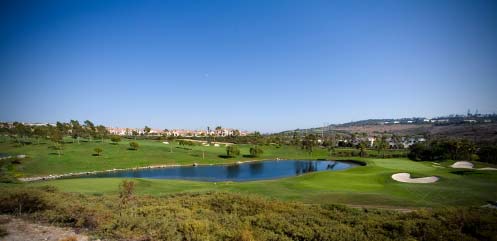How do golf courses contribute to stormwater pollutant loadings?
Some practices at golf courses have the potential to produce stormwater pollutants or contribute to increased stormwater runoff, including:
- Equipment and parts washing
- Fuel storage
- Use of pesticides/herbicides/fertilizers
- Watering of golf course grounds
These practices can contribute the following pollutants to Suffolk County’s waterways:
- Biodegradables (grass clippings, organic matter)
- Heavy metals
- Oil and grease
- Nutrients
- Pesticides/herbicides
- Soil and sediments
- Toxic and hazardous substances
These pollutants will eventually end up in Long Island’s bays, directly impacting recreational use, aesthetics, and wildlife habitat quality. Stormwater pollution can also have economic ramifications by decreasing the number of shellfish beds and fishing opportunities, with all these impacts making the area less attractive to tourists.
Just a few small changes in day-to-day activities could result in marked improvements in the quality of stormwater leaving your golf course and entering Suffolk County’s bays

Recommended Stormwater Best Management Practices for Golf Courses
Equipment Washing:
- Grass clippings and other organic matter washed off of mowing equipment quickly degrades and will deplete oxygen in surface waters. To prevent this, consider using air prior to water to remove organic debris from equipment. Contain equipment washing areas to make sure that these areas are not draining to storm drains or bodies of water. Collect grass clippings and organic matter when possible and dispose of properly.
- Consider installing an onsite biological treatment or recycling system for equipment wash water. These systems reclaim water and use microbes to degrade organic matter while allowing you to recycle the water for further equipment washing.
- Consider an onsite separation system that captures grass clippings and allows wash water to infiltrate underground. A system like this should only be used away from surface waters and if soaps and degreasers are not used in cleaning.
- Consider washing equipment (without soaps or chemicals) over turf and move wash stations around the grounds (though never near surface water) to prevent over-saturation.
- Spread all collected grass clippings in the rough or compost them on site.
- Traditional parts washers use mineral spirits and are considered hazardous waste. Consider switching to a non-hazardous alternative.
Fuel Storage:
- Fuel storage and pump areas should be located on impervious surfaces with secondary containment. This is required in Suffolk County per Suffolk County Sanitary Code with some exceptions.
- Locate fuel storage areas beneath a roof or use completely enclosed secondary containment structures to minimize infiltration of stormwater.
- If there is a spill, impervious surfaces are typically graded toward storm drains, directing the spills to surface waters. To prevent this consider using storm drain covers on nearby storm drains when fueling.
- Install fuel pump break-away valves to minimize the potential for a spill.
- Keep absorbents nearby to clean up minor fuel splatters or drips on site. Do not hose down the fueling area at any time.
Pesticide and/or Fertilizer Use:
- Pesticides should only be used as a last resort and when needed, the least toxic pesticide available should be used.
- Consider integrated pest management as an alternative, although completely stopping pesticide use is preferred.
- If pesticides are necessary, apply in spot treatments only where the pest is found.
- Leave grass clippings in the rough as a natural fertilizer.
- Any floor drains in handling areas should be connected to a holding tank which is pumped out on a regular basis by a professional. Consider plugging floor drains and cleaning up spills with dry methods, squeegees, and mopping.
- If fertilizers are used on site, they should never be applied when there is precipitation in the forecast or when the ground is frozen.
- Keep application equipment properly calibrated to avoid over-application. Store excess fertilizers safely indoors, do not apply excess to use it up.
- Do not apply fertilizers near surface water.
Conserve Water:
- Consider recycling irrigation water.
- Use low flow sprinklers and schedule and operate sprinklers in a manner that uses as little water as possible.
- Plant native grasses that are tolerant of minimal watering and, if irrigation water is recycled, lower water quality.
Other Important Things to Remember:
- Take time to read the label on all cleaning products. Use environmentally preferred products that are non-hazardous, have recycled content, are readily biodegradable, and non-toxic whenever possible.
- Train employees on proper pollution prevention practices and stormwater BMPs.
- Develop a spill prevention plan and make sure all employees know to contact the New York State Department of Environmental Conservation 24 hour spill hotline (1-800-457-7362) in the event of a spill.
References/More Information
- Carrow, R.N., R.R. Duncan & D. Wienecke. July 2005. BMPs approach to water conservation on golf courses. Golf Course Management, 73-76.
- Florida Department of Environmental Protection: Agricultural Source and Water Well Management Section. May 1995. Best Management Practices for Golf Course Maintenance Departments.http://www.dep.state.fl.us/water/nonpoint/docs/nonpoint/golfbmp.pdf
- Golf Course Superintendents Association of America. July 2005. Water Resources Protection webcast.
- The Green Industries of Colorado (GreenCo). May 2004. Green Industry Best Management Practices (BMPs) for the conservation and protection of water resources in Colorado. Wright Water Engineers, Inc., Boulder, CO. http://www.greenco.org/bmp_list.htm
- Suffolk County Sanitary Code. Article 12: Toxic and Hazardous Materials Storage Handling and Controls.http://gcp.esub.net/cgi-bin/om_isapi.dll?clientID=44804&infobase=suffolk.nfo&softpage=Browse_Frame_Pg42
- Peconic Estuary Program. Spring 2005. Is the grass really greener? Nitrogen and lawn care: do your part. PEP Talk, Vol 2, Issue 2, page 4. http://www.peconicestuary.org/PT_Spring05.pdf
- Pesticide Community Advisory Committee Policy for Suffolk County Golf Courses.http://www.cce.cornell.edu/suffolk/IPM/scgolf_pest_policy.pdf
- U.S. Environmental Protection Agency National Pollutant Discharge Elimination System. Pollution Prevention/Good Housekeeping for Municipal Operations: Landscaping and Lawn Care.http://cfpub.epa.gov/npdes/stormwater/menuofbmps/index.cfm?action=browse&Rbutton=detail&bmp=1
- U.S. Environmental Protection Agency National Pollutant Discharge Elimination System. Pollution Prevention/Good Housekeeping for Municipal Operations: Spill Response and Prevention.http://cfpub.epa.gov/npdes/stormwater/menuofbmps/index.cfm?action=browse&Rbutton=detail&bmp=107